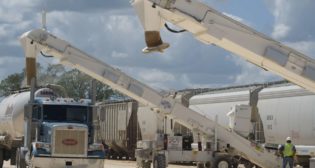
Intermodal’s explosive growth
Written by William C. Vantuono, Editor-in-ChiefWhen the Santa Fe Railway and J.B. Hunt formed the first real train/truck partnership in the 1980s, it was a catalyst for the growth of the domestic intermodal industry. Doublestacking also dates back to that period. Indeed, intermodal had more than its share of early advocates. It only made sense. Intermodal was fuel efficient. It reduced a number of operating costs. It gave shippers another transit option. Really, it was a very attractive alternative to traditional over-the-road long haul trucking. Except for one thing:
For the most part, nobody cared that 270 truckloads could be put on a single train.
Fuel, except for the occasional Mideast disturbance, was cheap. Railroads too often lacked the heightened customer focus essential to create truck competitive intermodal transit times. Furthermore, most of the intermodal infrastructure that was in place was not particularly well-designed for efficient truck/rail interchange.
Fast forward to today and we find that fuel is no longer cheap; railroads have transformed themselves into efficient, metric-driven and customer-oriented operations; and there now exists a nationwide network of state-of-the-art intermodal facilities. And that’s not all. The economics of long-haul trucking have grown increasingly challenging due to a combination of escalating fuel prices, driver shortages, stringent hours of service and safety requirements, and a deteriorating national highway and bridge infrastructure.
Put this perfect storm of forces together and it is hardly surprising that intermodal transit is experiencing explosive growth. From 2001 through 2010, intermodal loadings grew by approximately 30%, and that number would undoubtedly have been greater if not for the Great Recession, which slowed growth in 2008 and 2009.
Today, intermodal traffic accounts for about 21% of total U.S. rail revenue—second only to coal among all traffic segments. Moreover, it is arguable that we are only in the early innings of the transition to intermodalism. The process will gain progressively greater traction as railroads continue to be more efficiently operated than ever before, and not simply because of high energy costs or environmental concerns. An equally strong force at work comes in the form of North America’s largest trucking companies, which are driving the transition from over-the-road long haul trucking to intermodal.
Truckers are embracing the strategy that the most cost effective way for them to add capacity and increase profitably is not through investing in new tractors and recruiting more drivers, but by putting their containers or trailers on trains. When it comes to moving consumer goods over significant distances, more than one trucking executive has discovered the future of trucking is trains.
Our company, Kansas City Southern, has been an active participant in the transformation. Ten years ago, two things seriously restricted intermodal expansion on KCS. First, our U.S. railroad, The Kansas City Southern Railway Company, was geographically limited; intermodal hauls ranged from 250 to 350 miles—barely sufficient to be profitable and not long enough to maximize the economic benefits of the intermodal option. This situation changed dramatically with the acquisition of total ownership of the Mexican railroad now named Kansas City Southern de Mexico, S.A. de C.V. The combined system can offer shippers an array of efficient intermodal products that range from 300 to 2,000 miles.
The second drag on our intermodal growth was that we lacked the adequate infrastructure to compete effectively. The price of entry into the market was investment in our system. To that end, from 2005 through 2010, KCS expanded and modernized its intermodal infrastructure. The process gained momentum when KCS and Norfolk Southern formed a joint venture to develop KCS’ Meridian Speedway, a 320-mile rail corridor between Shreveport, La. and Meridian, Miss. The Meridian Speedway is an integral segment of the fastest, most direct rail corridor between southern California and the southeast region. Improvements that were the direct outcome of the KCS/NS joint venture have more than doubled the corridor’s capacity while reducing transit times by approximately one-third. As a result, we have witnessed dramatic intermodal business over the Meridian Speedway working with our rail partners, NS and Union Pacific.
Simultaneous with the Meridian Speedway upgrade, KCS was investing more than $275 million in improvements to what we now call our International Intermodal Corridor, which runs between Houston and Lazaro Cardenas. The improvements include upgrades or expansion of facilities at Lazaro Cardenas, Toluca, San Luis Potosi, Monterrey, and Rosenberg/Houston.
The investment also included the complete renewal of the rail line between Rosenberg and Victoria, Tex., shortening the route by 67 miles and ensuring greater consistency and speed of cross-border transit. The renewal of the Victoria-Rosenberg track and the investment in its U.S. and Mexican intermodal terminals has allowed KCS to provide a total package that includes cost-effective and efficient transportation, as well as storage and protection of freight while in transit. This has enabled the company to become a premium cross-border intermodal service provider.
The market is clearly responding. During the first half of 2011, KCS’ cross-border volumes grew by 39% and revenues increased by 55%. Overall, intermodal volumes grew 31% in 2010 and revenues by 35%. Even with the tough comps of 2010 to measure our performance, first-half 2011 volumes are up 15% and revenues have increased by 26%.
As robust as these numbers are, KCS has barely begun to scratch the surface of its intermodal opportunity. Today, 2.6 million truckloads cross the border serving markets where KCS operates. Despite the impressive growth we’ve experienced during the past year and a half, KCS still has less than 1% of the addressable cross-border intermodal market, which suggests that we will continue to enjoy strong growth for an extended time.
The same can be said for our international intermodal business out of Lazaro Cardenas. During the first half of 2011, KCS container volumes out of Lazaro Cardenas grew by 35% and revenues by 39%. Hutchison Port Holdings, the operator of the initial Lazaro port concession, is presently engaged in an expansion program at the port that will take capacity from 750,000 Twenty-foot Equivalent Units (TEUs) to approximately 2.5 million TEUs. Additionally, the Mexican government has initiated a bid process for a second port concession at Lazaro. Combined, these concessions can take capacity at Lazaro Cardenas up to about five million TEUs over the next decade. As the sole railroad serving the port, what is exciting for KCS is that, just as we’ve only scratched the surface of the cross-border intermodal market, our international intermodal growth out of Lazaro Cardenas is also very much still in its infancy and we should attain outstanding growth in this market for many years.
While KCS’ exposure to Mexico’s rapidly growing economy and our penetration into the expanding Texas and southeastern markets provides us with exceptional intermodal growth opportunities, the myriad secular forces at work suggest that all the North American railroads will benefit from the explosive growth of intermodal. And, unlike 20 years ago when discussions of intermodal more often than not provoked yawns from shippers, trucking companies, financial analysts, and investors, today we have everybody’s attention.

![“This record growth [in fiscal year 2024’s third quarter] is a direct result of our innovative logistic solutions during supply chain disruptions as shippers focus on diversifying their trade lanes,” Port NOLA President and CEO and New Orleans Public Belt (NOPB) CEO Brandy D. Christian said during a May 2 announcement (Port NOLA Photograph)](https://www.railwayage.com/wp-content/uploads/2024/05/portnola-315x168.png)

